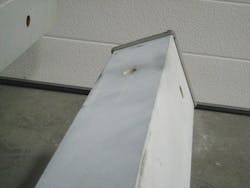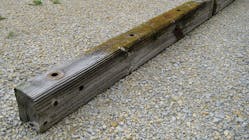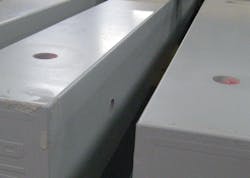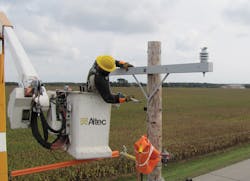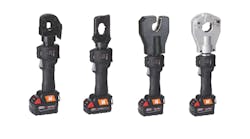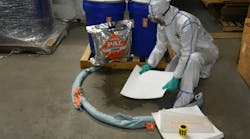A wood pole caught on fire in March 2010 in Colorado Springs, Colorado, causing an energized conductor to fall across a major interstate. The incident backed up rush-hour traffic for miles and knocked out power to the nearby Air Force Academy for an hour.
Upon further investigation, Colorado Springs Utilities determined that magnesium chloride, or road salt, had built up on the insulators and crosssarms, which caused the leakage current to track. Combined with the continuous arcing, the wood crossarm caught fire. The burning of the wood pole then triggered the top portion of the pole to collapse onto itself, causing a flashover of the conductors and the melting of the phase conductors.
This high-profile failure drove Colorado Springs Utilities to research and implement a solution that would prevent a failure such as this one from happening again.
Exploring Wood Alternatives
Pole fires increased between 2011 and 2012, coincidentally, with the city’s increased usage of liquidized road salt on the highways during the winter months. The Colorado Department of Transportation uses this solution before a snowstorm to prevent snow and ice from bonding to the highway. It is believed that as vehicles travel at high speeds, they kick up the liquidized magnesium chloride, send it airborne and cause it to be deposited on crossarms, insulators and other parts of an electrical structure.
When insulation levels are compromised because of contamination or moisture consumption, leakage current flow, or tracking, can increase and, under certain conditions, can potentially create enough heat to result in a pole-top fire. This risk of fire can increase or decrease depending on the type of material used in the pole’s construction and design. Although traditionally constructed of wood, today’s crossarms are also made of steel and fiberglass. The challenge with wood, like other biodegradable materials, is that it is susceptible to contamination and deterioration.
Pole fires are common challenges among electricity providers in parts of the world where contaminations such as coal dust, salt, airborne pollution or dust build up on insulating equipment followed by a weather event. For example, a light misting rain can combine with contaminants on the insulating hardware and create a bond between the contaminants. The contaminated water droplets then begin to form and establish paths from the energized overhead conductor to the crossarm. This provides an electrical path for tracking to occur. When tracking occurs from the energized conductor to the surface of the crossarm, small arcs are generated between the wood and the through-bolt that is used to attach the crossarm to the pole. The crossarm through-bolt is a common area for a pole fire to initiate because of the minimal surface area contact and high electrical resistance. Also, this area tends to be dry, which can cause it to ignite more easily.
For that reason, some electric utilities are adding fiberglass crossarms to their electric transmission and distribution infrastructure as a way to reduce pole-top fires. Fiberglass crossarms are good electrical insulators and have a high mechanical strength-to-weight ratio. They also have a projected service life of more than 60 years and can be used in virtually any environmental condition — from arid, dry areas to more humid climates.
Composite materials, like fiberglass, also have about twice the service life of wood products and are impervious to damage caused by nature, such as birds, insects, rot or mildew. For these reasons, as well as its high-insulating value, fiberglass has already replaced a large number of wood products in the utility industry — like ladders, hot sticks and tool handles — for more reliable performance and longer life.
Installing Fiberglass Crossarms
To reduce the risk of pole-top fires, Colorado Springs Utilities reached out to GEOTEK, which makes PUPI fiberglass crossarms and braces. The manufacturer shared the experience of an electrical utility in Alberta, Canada, that had once experienced 80 pole fires in two days. To remedy the situation and to prevent future fires, this utility is in the process of replacing its wood crossarm infrastructure with 10,000 fiberglass ones. So far, the utility has not reported any pole files to the company.
Following this research, Colorado Springs Utilities has since started to replace its existing crossarm infrastructure in pole-fire-susceptible areas with PUPI fiberglass crossarms. Line construction crews have been installing fiberglass deadend crossarms for more than two years, and fiberglass is now the standard for the company’s deadend crossarm construction.
In addition, installing fiberglass crossarms with silicone rubber insulators has been shown to give better protection against pole files. While these insulators are about 12 times the cost of standard porcelain insulators, they can help to minimize the risk of another energized line dropping onto a roadway. For that reason, the linemen install the fiberglass crossarms and silicone rubber insulators on the adjacent wood structure on both sides of the highway.
The PUPI fiberglass crossarms also employ a patented thermally-bonded SunGUARD UV-resistant coating. This UV-resistant coating is designed to add another layer of protection against UV radiation on the crossarm’s surface. Also, by making the surface smooth, it can shed water and contaminants, and minimize the risk of tracking.
Another benefit of using PUPI fiberglass crossarms is that because they are made of inorganic materials, they are flame-resistant and self-extinguishing. Once the heat source is removed, the fiberglass crossarms can significantly reduce the potential of damage caused by a pole-top flare-up.
So far, Colorado Springs Utilities has installed approximately 200 deadend fiberglass crossarms and 125 tangent fiberglass crossarms. The utility first began installing the tangent fiberglass crossarms back in 2010 on a section of overhead line for the U.S. Air Force Academy. On this project, the linemen installed 41 crossarms on 22 poles spanning one mile. Prior to this project, the only fiberglass crossarms being installed were deadend crossarms and the pre-assembled overhead gang-operated switch crossarms.
Today, linemen are installing fiberglass crossarms throughout Colorado Springs Utilities’ service territory as a way to harden the system and reduce the risk for pole-top fires. As the City of Colorado Springs and the Colorado Department of Transportation continue to use the road salt to melt ice and snow on the roadways, the utility is protecting its electrical infrastructure and improving power reliability.
Steve Torres ([email protected]), a project engineer, joined Colorado Springs Utilities in 2000. He spent four years working part-time as an instrumentation, electronic and control technician intern for the water/wastewater department and then began working as an engineer for the engineering standard section. He graduated in 2004 from Colorado State University with a bachelor’s degree in electrical engineering.
Companies mentioned:
Colorado Springs Utilities | www.csu.org
GEOTEK | www.geotekinc.com

